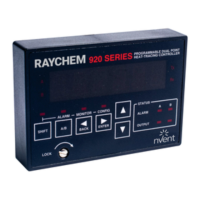55 / 82
EN- Raychem920series-IM-H5687405/15
INDUSTRIAL HEAT TRACING SOLUTIONS
If the bounce or instability is excessive, check:
• WireusedforextensionoftheRTDshouldbethree-wire,twistedandshieldedwiththeshield
grounded at the controller only. Each of the three lead wires must be of the same gauge.
• TheidealinstallationhasaseparateconduitfortheRTDleads(iftheyhavebeenextended).It
is not usually a problem to run low signal levels in the same conduit as the power leads even in
high-power applications, as long as the RTD wire is a twisted, shielded type with an insulation
rating equal to or greater than the highest voltage in the conduit. Follow the proper Electrical
Code for your particular in-stallation.
• TerminalconnectionsthatarenottightcanaddresistancetoanRTDcircuit.Checkthe
tightness of all screw terminal connections at time of installation and during subsequent
maintenance checks.
• Checkthespecificationsfortheparticularcablebeingusedtoensurethatitdoesnothave
excessive capacitance when used in long lengths. This can cause a temperature offset between
what the controller reads and what the RTD actually measures. This again is normally not a
problem since the controller compensates for all but the worst cases of this.
• Lastly,itispossiblefortheRTDitselftofailonanintermittentbasisbutthisfailuremode
should be considered unusual. This kind of failure is probably the most difficult to find but
fortunately it is also the least likely as a failure mechanism.
6.2.3 GROUND FAULT
Ground-fault alarms can be due to incorrect installation as well as leakage resulting from wet
system components or faulted cables.
The 920 series switch interface detects ground faults by summing the outgoing and return trace
currents through an internal current trans-former. Under normal operating conditions (no ground
fault condition) this current will be zero. When there is a flow of current from one of the trace
supply wires to ground, a ground-fault condition occurs.
If a ground-fault alarm is present on start-up of a new installation, it is likely due to a wiring error
or damaged cable. To verify this condition:
• Checkthattheheatingcircuitneutralsreturntothecontrollerandarenotconnecteddirectlyto
the distribution panel. This can be a common problem if the installation is a retrofit situation.
• Onparalleledcircuits,becertainthatALLneutralsreturn.Thelateadditionofacircuitmaynot
be obvious.
Use the monitoring feature available at the 920 Operator Console or the Model 780/GCC-9000
Group Communications Controller to view the measured ground-fault current at the heat-
trace controller. If this value is at the maximum that the controller can measure, it is usually an
indication that the wiring is incorrect. If the value is less than 250 mAmps, an actual ground-fault
condition may exist in the cable.
IMPORTANT: The controller monitors the integrity of the ground-fault (GF) detection transformer
and associated wiring. If a fault is detected, the controller will report a GF value of 300 mAmps.

